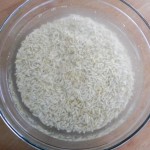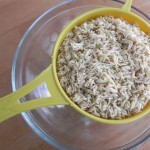Brown Rice can be a nourishing food in your diet. But like all grains it contains Phytic Acid which blocks your absorption of those great nutrients. Soaking the brown rice alone is not enough to make these nutrients available. The rice must be germinated (sprouted) in order to get the most out of it.
It is said that traditional cultures germinated their rice before consuming it. This germinated rice is also called “sprouted” brown rice, GABA brown rice (for the amino acid GABA, gamma aminobutyric acid, that is created during the sprouting), or hatsuga genmai in Japanese.
Germinated rice is easier to digest and has more bio-available nutrients.
Health benefits of consuming germinated brown rice in lieu of regular rice — improved brain function, relief of some menopause symptoms, lower blood pressure, prevent headaches, relieve constipation, regulate blood sugar etc.
How to Germinate Brown Rice
Any kind of brown rice can be germinated, from short grain, long grain, and even sweet brown rice. Follow these simple instructions for an easy, delicious way to get the most nutrition out of your rice.
Rinse and drain rice in this manner for 1 to 2 days, or until a very tiny sprout emerges from the rice grain. (Do not let the sprout get too long or the taste of the rice will be effected.)
Use the germinated rice right away or store the well drained (patted dry) rice in the fridge for 1 or 2 days until ready to use. Germinated brown rice will take slightly less water and time to cook. So adjust accordingly.
If you do not want to “sprout” the rice yourself, germinated brown rice is available for purchase in some areas. Look for it in your local Asian market or purchase it online.
For more information:
— http://scienceblog.com/community/older/2000/A/200000373.html
— http://enzymo.wordpress.com/2008/07/11/germinated-brown-rice
— http://www.gabarice.info/gaba-gamma-aminobutyric-acid/
Find our more ways to reduce Phytic Acid in your foods.
 Email To A Friend
Email To A Friend Print This Page
Print This Page




A friend of mine has had luck sprouting Tsuru Mai California Brown Rice. I’d like to ask, what other brand names and types of rice have you and other folks here had luck sprouting? Please share. Thank you.
Eric, I really don’t know of or go by brand names. So far I’ve sprouted regular long grain brown rice and short grain brown rice. I haven’t tried any others yet.
I just bought Brown Basmati rice from Whole Foods. It took 3 days to start the sprouting but on the fourth day it’s fully sprouted!
Hi, I have a question. After I sprout the brown rice, if I don’t want to cook it and I just want to eat it as is, do you know if it will be safe to eat the freshly sprouted brown rice cold and unheated in any way?
Jay, rice has to be cooked before it is eaten or it will just be hard and crunchy.
Can I use stainless steel colander for sprouting the rice?
thanks.
Yes you can use a stainless steel colander. Just make sure that the little grains of rice will not fall through the holes in the colander.
I used the jar with a metal mesh at the lid.
Hi Shannon, You say sprouted rice takes less time to cook and less water, but how much less? Currently I put a portion of ‘normal’ brown rice in the saucepan, cover it with what looks like twice the amount of water, bring it to the boil , then reduce heat, cover and simmer for 20 mins before turning off the heat and leaving it to sit for ten mins.
Cathy, how much less water you use would vary depending on how long you soaked the rice and how much rice was soaked. I would try using about 1/2 cup less water and keep any eye on the rice when it cooks. You can always add a little more water if needed (if the rice looks like it is getting too dry).
Thanks for that Shannon. Cooking the stuff is proving no problem. What I’m having trouble with is getting it to sprout at all. I’ve been trying to sprout a mixed bag of brown basmati, red and wild rices. The wild rice took just a day, but the red has taken four to start, and the blasted basmati is only starting to sprout now, on day six! Added to that the jar gives off a sour smell, even though I rinse it thoroughly twice a day. I never have these problems with beans
Hiya, does anyone have an answer to why I’m finding it impossible to sprout rice? I was hoping someone would respond to my last comment by pointing out where I’m going wrong. I soak the rice overnight, drain it and stand it upside-down over a bowl, at an angle, in a sprouting jar, in the back of a low-level cupboard, and then rinse it out twice a day.
Cathy, sorry for any confusion. I didn’t see a question in the last comment. It does not appear that you are doing anything wrong. If you are getting the other types of rice to sprout, then it would appear that it there must be something wrong with the rice itself. I would suggest trying a different type of brand of rice and see how that works out. 🙂
That’s ok Shannon, thanks for that. I’ll give up on basmati and see how I get on with regular brown long grain
While soaking brown rice, can I add minerals like Mg,Ca, Fe,Cr,Cu etc to correct the deficiency of these minerals? Please reply.
Keep in mind that soaking helps to release the nutrients of grains, this includes minerals. Personally I would not add minerals to food while I am soaking it. My biggest concern here would be how do I know how much of each mineral to add and how do I know what the food (brown rice in this case) is deficient in. I would think it better to take a mineral supplement where the amounts are correctly balanced that way I would not get incorrect amounts of different minerals. We have to be careful not to fall into the trap of trying to over-science food.
thanks for the information.
After you sprout the rice, can you dehydrate it and store it without affecting the nutritional value?
Fresh foods will always be better in nutrition when they are alive. By eating the sprouts fresh you will loose the added work of dehydrating. Do be cautious in that you are not trying to make healthy foods that mimic processed boxed foods. Personally I would store the beans or rice and then sprout them as I needed them, eating them freshly sprouted.
Thanks!! 🙂
I’m just trying to get the most nutritious/digestible food for my family while not always waiting 2 or 3 days to get it!! 🙂
It is certainly much more convenient to have correctly dehydrated (in a quality dehydrator that regulates the temperature to stay below 110 degrees) sprouted brown rice on hand than to have to plan three days in advance for when you want to have rice for a meal. Plus, it has to be dehydrated for making flour out of.
After the rice is sprouted and ready for use, how do you cook it? does fully boiling it kill the sprout and the nutrients? What’s the best way to prepare sprouted rice or other sprouted grains?
The rice should be cooked as you would normal rice. Some of the enzymes will be “killed”. But the whole purpose of sprouting the rice is to “unlock” the nutrients in the rice so that your body can digest / absorb them.
As usual Im behind on things. I have been working on converting from bad cookware to stainless steel the last couple of years and now I see that ceramic cookware is better. Is that true?
Stainless Steel is one of the lesser evils. If that is all you can afford, by all means it is better to use it than other cookware such as non-stick/teflon, anodized aluminum, aluminum, etc. I still use some of my stainless steel pans. But yes, to answer your question, Cermaic cookware is better… that is if you make sure you get a qualty brand. You can check out the review we did on the Xtrema Ceramic Cookware and the Xtrema Ceramic Bakeware. Hopefully it should help shed some light on the whole cookware subject. There is also a lesson in our free eCourse that covers cookware.
so when you are rinsing the rice every 8 hours or so, you leave it bunched up in the colander and cover with a towel?
Yes, after rinsing the rice shake off the excess water and let it hang (the colander) over a bowl. Cover this with a towel to keep dust and bugs out.
I just saw that you already answered my question. Sorry for the duplication.
Do you think using a rice maker with a GABA setting is sufficient?
My rice maker has a GABA setting. It usually takes a minimum of six hours to prepare it on this setting. Do have any knowledge of rice makers with this setting? I’m thinking it’s preparing the rice well, but I’m curious to know your thoughts.
Sorry Katie, I do not have any knowledge on those types of rice cookers. The one I have does not have a GABA setting.
Though I did a quick search and found that… “most GABA rice cookers soak the rice for 2 hours before cooking at 104 degrees to activate the GABA.” Now if it only soaks for 2 hours or even up to 6, I do not think this short amount of time will neutralize the Phytic Acid sufficiently. That is my only concern.